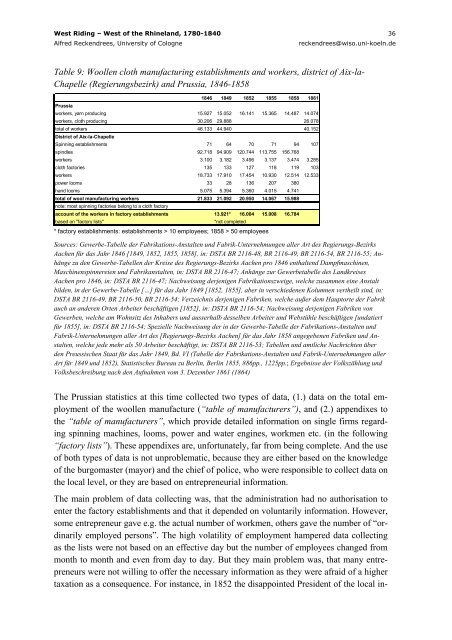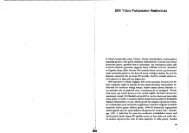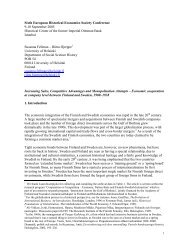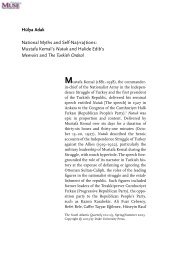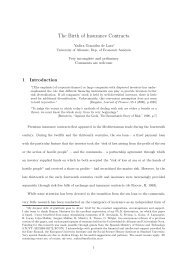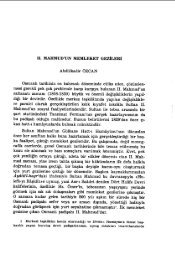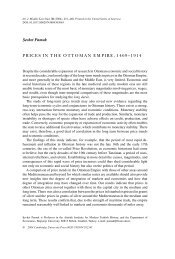West Riding – Western Rhineprovince, 1790-1840: Diverse Paths to ...
West Riding – Western Rhineprovince, 1790-1840: Diverse Paths to ...
West Riding – Western Rhineprovince, 1790-1840: Diverse Paths to ...
You also want an ePaper? Increase the reach of your titles
YUMPU automatically turns print PDFs into web optimized ePapers that Google loves.
<strong>West</strong> <strong>Riding</strong> <strong>–</strong> <strong>West</strong> of the Rhineland, 1780-<strong>1840</strong> 36<br />
Alfred Reckendrees, University of Cologne reckendrees@wiso.uni-koeln.de<br />
Table 9: Woollen cloth manufacturing establishments and workers, district of Aix-la-<br />
Chapelle (Regierungsbezirk) and Prussia, 1846-1858<br />
Prussia<br />
1846 1849 1852 1855 1858 1861<br />
workers, yarn producing 15.927 15.052 16.141 15.365 14.487 14.074<br />
workers, cloth producing 30.206 29.888 26.078<br />
<strong>to</strong>tal of workers 46.133 44.940 40.152<br />
District of Aix-la-Chapelle<br />
Spinning establishments 71 64 70 71 94 107<br />
spindles 92.718 94.909 120.744 113.755 156.768<br />
workers 3.100 3.182 3.496 3.137 3.474 3.285<br />
cloth fac<strong>to</strong>ries 135 133 127 118 119 103<br />
workers 18.733 17.910 17.454 10.930 12.514 12.533<br />
power looms 33 28 136 207 380<br />
hand looms 5.075 5.394 5.360 4.015 4.741<br />
<strong>to</strong>tal of wool manufacturing workers 21.833 21.092 20.950 14.067 15.988<br />
note: most spinning fac<strong>to</strong>ries belong <strong>to</strong> a cloth fac<strong>to</strong>ry<br />
account of the workers in fac<strong>to</strong>ry establishments 13.921* 16.004 15.008 16.784<br />
based on "fac<strong>to</strong>ry lists" *not completed<br />
* fac<strong>to</strong>ry establishments: establishments > 10 employees; 1858 > 50 employees<br />
Sources: Gewerbe-Tabelle der Fabrikations-Anstalten und Fabrik-Unternehmungen aller Art des Regierungs-Bezirks<br />
Aachen für das Jahr 1846 [1849, 1852, 1855, 1858], in: DSTA BR 2116-48, BR 2116-49, BR 2116-54, BR 2116-55; Anhänge<br />
zu den Gewerbe-Tabellen der Kreise des Regierungs-Bezirks Aachen pro 1846 enthaltend Dampfmaschinen,<br />
Maschinenspinnereien und Fabrikanstalten, in: DSTA BR 2116-47; Anhänge zur Gewerbetabelle des Landkreises<br />
Aachen pro 1846, in: DSTA BR 2116-47; Nachweisung derjenigen Fabrikationszweige, welche zusammen eine Anstalt<br />
bilden, in der Gewerbe-Tabelle […] für das Jahr 1849 [1852, 1855], aber in verschiedenen Kolumnen vertheilt sind, in:<br />
DSTA BR 2116-49, BR 2116-50, BR 2116-54; Verzeichnis derjenigen Fabriken, welche außer dem Haup<strong>to</strong>rte der Fabrik<br />
auch an anderen Orten Arbeiter beschäftigen [1852], in: DSTA BR 2116-54; Nachweisung derjenigen Fabriken von<br />
Gewerben, welche am Wohnsitz des Inhabers und ausserhalb desselben Arbeiter und Webstühle beschäftigen [undatiert<br />
für 1855], in: DSTA BR 2116-54; Spezielle Nachweisung der in der Gewerbe-Tabelle der Fabrikations-Anstalten und<br />
Fabrik-Unternehmungen aller Art des [Regierungs-Bezirks Aachen] für das Jahr 1858 angegebenen Fabriken und Anstalten,<br />
welche jede mehr als 50 Arbeiter beschäftigt, in: DSTA BR 2116-53; Tabellen und amtliche Nachrichten über<br />
den Preussischen Staat für das Jahr 1849, Bd. VI (Tabelle der Fabrikations-Anstalten und Fabrik-Unternehmungen aller<br />
Art für 1849 und 1852), Statistisches Bureau zu Berlin, Berlin 1855, 886pp., 1225pp.; Ergebnisse der Volkszählung und<br />
Volksbeschreibung nach den Aufnahmen vom 3. Dezember 1861 (1864)<br />
The Prussian statistics at this time collected two types of data, (1.) data on the <strong>to</strong>tal employment<br />
of the woollen manufacture (“table of manufacturers”), and (2.) appendixes <strong>to</strong><br />
the “table of manufacturers”, which provide detailed information on single firms regarding<br />
spinning machines, looms, power and water engines, workmen etc. (in the following<br />
“fac<strong>to</strong>ry lists”). These appendixes are, unfortunately, far from being complete. And the use<br />
of both types of data is not unproblematic, because they are either based on the knowledge<br />
of the burgomaster (mayor) and the chief of police, who were responsible <strong>to</strong> collect data on<br />
the local level, or they are based on entrepreneurial information.<br />
The main problem of data collecting was, that the administration had no authorisation <strong>to</strong><br />
enter the fac<strong>to</strong>ry establishments and that it depended on voluntarily information. However,<br />
some entrepreneur gave e.g. the actual number of workmen, others gave the number of “ordinarily<br />
employed persons”. The high volatility of employment hampered data collecting<br />
as the lists were not based on an effective day but the number of employees changed from<br />
month <strong>to</strong> month and even from day <strong>to</strong> day. But they main problem was, that many entrepreneurs<br />
were not willing <strong>to</strong> offer the necessary information as they were afraid of a higher<br />
taxation as a consequence. For instance, in 1852 the disappointed President of the local in-


